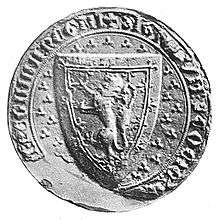Guardian of Scotland

The Guardians of Scotland were the de facto heads of state of Scotland[1] during the First Interregnum of 1290–1292, and the Second Interregnum of 1296–1306. During the many years of minority in Scotland's subsequent history, there were many guardians of Scotland and the post was a significant constitutional feature in the course of development for politics in the country.
Guardians of Scotland during the First Interregnum 1290–1292
- William Fraser, Bishop of St Andrews
- Robert Wishart, Bishop of Glasgow
- John II Comyn, Lord of Badenoch
- James Stewart, 5th High Steward of Scotland
- Alexander Comyn, Earl of Buchan
- Donnchadh III, Earl of Fife
In a letter (written in Old French) from the Scots Parliament of 1290, sitting at Birgham, confirming the Treaty of Salisbury, the guardians of Scotland are listed as:[2]
"... Guillaume de Seint Andreu et Robert de Glasgu evesques, Johan Comyn et James Seneschal de Escoce, gardeins du reaume de Escoce..."
English translation: "William [Fraser] of St Andrews and Robert [Wishart] of Glasgow bishops, John Comyn and James the Steward of Scotland, guardians of the kingdom of Scotland".
- Bryan FitzAlan, Lord FitzAlan (13 June 1291-????)
Guardians of Scotland during the Second Interregnum 1296–1306
| Guardians of the Kingdom of Scotland | ||
|---|---|---|
| Guardian (Time in office) | ||
| Sir William Wallace (1297–1298) | ||
| Sir Robert the Bruce (1298–1300) |
John III Comyn (1298–1301) |
— |
| William de Lamberton (1299–1301) | ||
| Sir Ingram de Umfraville (1300–1301) | ||
| Sir John de Soules (1301–1304) | ||
Guardians during the minority and reign of David II
The Guardians during the minority and reign of David II were:
- Sir Thomas Randolph, 1st Earl of Moray (1329–1332), appointed by the Act of Settlement of 1318.
- Donald, Earl of Mar (1332, for ten days)
- Sir Andrew Moray of Bothwell (1332–1333) until captured by the English.
- Sir Archibald Douglas (1333, for three months)
- Sir Andrew Moray of Bothwell for the second time (1335–1338)
- Robert the Steward, nephew (older in years) to David and future king of Scotland. Robert was guardian on four occasions, sometimes jointly, and latterly twice during the eleven years of the king's enforced absence as a prisoner in England after the Battle of Neville's Cross (1345–1357). He used these years to build a large power base in the country, especially north of the Forth.
See also
References
- ↑ Barrow, G. W. S. (2005). Robert Bruce and the community of the realm of Scotland. Edinburgh University Press. p. 38. ISBN 9780748620227. Retrieved 2009-10-14.
- ↑ "Margaret: Manuscript - 1290, 14 March, Birgham - Parliamentary Records - Letters: confirmation of the treaty of Salisbury" (in Old French and English). Records of the Parliaments of Scotland to 1707, University of St Andrews. Retrieved 2009-10-03.
- Mack, James Logan (1926). The Border Line. Pub. Oliver & Boyd. pp. 317–322.
- McNaught, Duncan (1912). Kilmaurs Parish and Burgh. Pub. A.Gardner. p. 9.